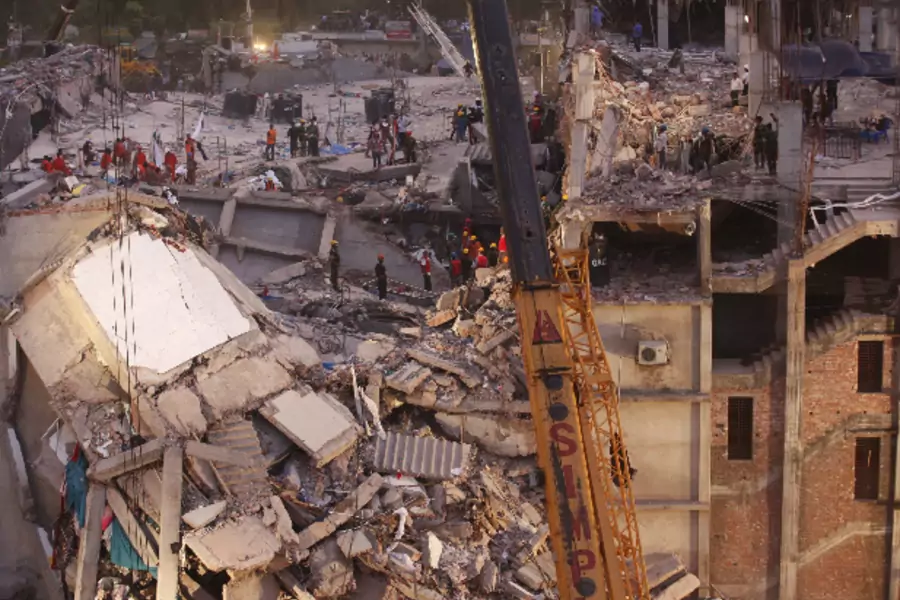A Guide to the Rana Plaza Tragedy, and its Implications, in Bangladesh

More on:
One year ago today, April 24, the world watched with horror as a concrete building known as “Rana Plaza” cracked, buckled, and ultimately collapsed atop the garment workers inside its factories. It would turn out to be the worst accident in the garment industry anywhere. More than 1,100 people were killed, and 2,500 injured.
I wrote this week that Bangladesh must move fast to preserve the garment sector’s successes. It may seem strange to focus on this industry’s successes when recalling such a tragedy. Yet the garment industry has been signally important to Bangladesh’s economic well-being, providing nearly 80 percent of the country’s overall exports and employing some four million people. The industry’s workforce is primarily women, and empowering them has been positive for Bangladesh as well. But basic factory safety must be met, otherwise retailers and brands will look to less risky places to source their garments.
The Rana Plaza tragedy spurred the government of Bangladesh, workers, factory owners, associations, international buyers, international organizations, and the United States and European Union (EU) to mount public-private partnerships suited to addressing the scale of Bangladesh’s garment industry challenge. This will not be easy. Bangladesh is now the world’s number two garment exporter, second only to China, and it has nearly six thousand factories manufacturing for export. Given the many pieces of this issue, I thought it could be helpful to provide a guide to primary sources of information to supplement my op-ed.
In 2013, Bangladesh passed labor law amendments (in Bengali; International Labor Organization comment in English here) which most importantly strengthened workers’ right to freedom of association and collective bargaining. This law made it possible for Bangladesh to at last become part of an International Labor Organization-International Finance Corporation (ILO-IFC) program called Better Work. Better Work provides in-depth assessment and advice to individual factories.
The Bangladesh Garment Manufacturers Export Association is the most important association coordinating ready-made garment (RMG) exports from Bangladesh. It tracks data from its members, such as the size and growth of the industry over the last three decades, and the composition of RMG exports as a total of Bangladesh’s overall exports.
In the wake of the tragedy, European and American retailers and brands came together to form organizations focused on ensuring quality, intensive inspection and remediation of problems in the factories they source from. The Bangladesh Accord on Fire and Building Safety involves Europe’s largest retailers and brands, and some American brands, along with the ILO. The Alliance for Bangladesh Worker Safety, which grew out of an initiative led by retired senators George Mitchell and Olympia Snowe, under the auspices of the Bipartisan Policy Center, involves twenty-six American and Canadian brands.
The tragedy led to a decision in Washington by President Obama to suspend trade preferences to Bangladesh under the Generalized System of Preferences, known as GSP. An action plan charts out steps Bangladesh can take to requalify for GSP. Since last July, the entire GSP program has been held in abeyance since the U.S. Congress has not reauthorized it.
In July 2013, a meeting in Geneva resulted in an EU-ILO-Government of Bangladesh Sustainability Compact, which focuses on “continuous improvements in labor rights and factory safety.” The United States issued a statement later that month associating the U.S. government with the compact, and releasing the GSP action plan. The ILO also created a compensation fund, the Rana Plaza Donors Trust Fund, for victims of the tragedy.
The U.S. Senate Foreign Relations Committee has paid particular attention to the policy implications of Bangladesh’s garment sector and its workplace safety and labor issues. A report prepared by majority staff was released in November 2013.
BRAC USA announced a new fund to support victims of the Rana Plaza and other garment industry accidents in Bangladesh. The fund is named the Bangladesh Humanitarian Fund.
At New York University, the Stern School’s Center for Business and Human Rights released a report, “Business as Usual is Not an Option” focused on what should be done in the post-Rana Plaza world of global supply chains.
Follow me on Twitter: @AyresAlyssa
More on:
 Online Store
Online Store